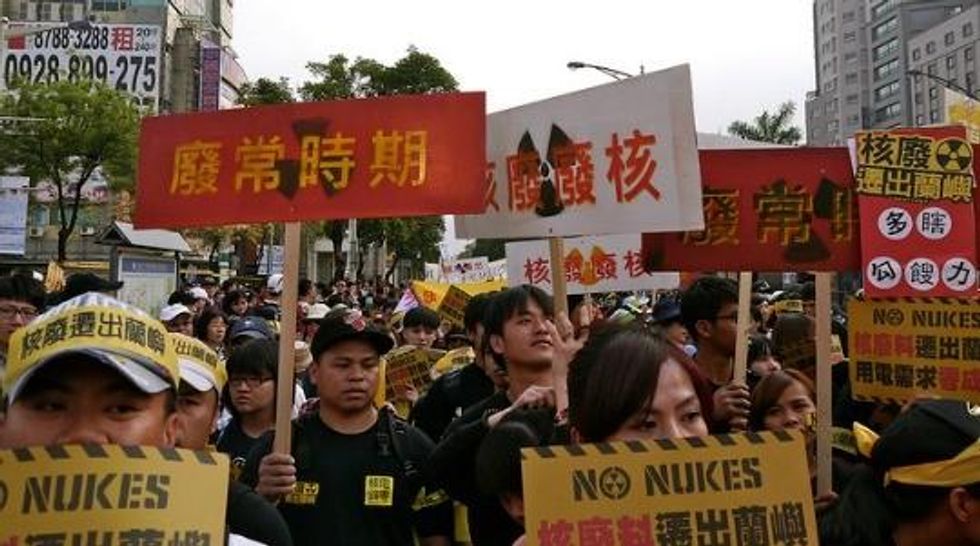

SUBSCRIBE TO OUR FREE NEWSLETTER
Daily news & progressive opinion—funded by the people, not the corporations—delivered straight to your inbox.
5
#000000
#FFFFFF
To donate by check, phone, or other method, see our More Ways to Give page.


Daily news & progressive opinion—funded by the people, not the corporations—delivered straight to your inbox.

Though new leaks were not found, the hotspots detected Thursday were emitting between 70 and 100 millisieverts an hour, the high end of which is the maximum exposure allowed for nuclear plant workers over a five-year period, and the same amount workers detected in pools of leaked water on Tuesday.
TEPCO's announcement two days ago that 300 metric tons of water had leaked from a storage tank prompted Japanese authorities to up the threat level to "serious," and marked only the latest in a series of leaks and mishaps in the never-ending emergency at the disaster-stricken nuclear plant.
As bad as the situation seems, Mycle Schneider, lead author for the World Nuclear Industry status reports, told BBC News that the situation "is much worse than we have been led to believe, much worse."
He warned that they are dealing with "absolutely gigantic" amounts of radioactive water, and that there were leaks "not just from the tanks. It is leaking out from the basements, it is leaking out from the cracks all over the place. Nobody can measure that," Schneider told BBC.
Apart from the unsustainable contaminated water-storage system and leak after leak allowing radioactivity to pour into the ground and ocean, alarms were raised over plans to remove fuel rods containing radioactive material equivalent to 14,000 times the amount released in the atomic bombing of Hiroshima, a plan that "has never been attempted before on this scale."
________________________
Dear Common Dreams reader, The U.S. is on a fast track to authoritarianism like nothing I've ever seen. Meanwhile, corporate news outlets are utterly capitulating to Trump, twisting their coverage to avoid drawing his ire while lining up to stuff cash in his pockets. That's why I believe that Common Dreams is doing the best and most consequential reporting that we've ever done. Our small but mighty team is a progressive reporting powerhouse, covering the news every day that the corporate media never will. Our mission has always been simple: To inform. To inspire. And to ignite change for the common good. Now here's the key piece that I want all our readers to understand: None of this would be possible without your financial support. That's not just some fundraising cliche. It's the absolute and literal truth. We don't accept corporate advertising and never will. We don't have a paywall because we don't think people should be blocked from critical news based on their ability to pay. Everything we do is funded by the donations of readers like you. Will you donate now to help power the nonprofit, independent reporting of Common Dreams? Thank you for being a vital member of our community. Together, we can keep independent journalism alive when it’s needed most. - Craig Brown, Co-founder |

Though new leaks were not found, the hotspots detected Thursday were emitting between 70 and 100 millisieverts an hour, the high end of which is the maximum exposure allowed for nuclear plant workers over a five-year period, and the same amount workers detected in pools of leaked water on Tuesday.
TEPCO's announcement two days ago that 300 metric tons of water had leaked from a storage tank prompted Japanese authorities to up the threat level to "serious," and marked only the latest in a series of leaks and mishaps in the never-ending emergency at the disaster-stricken nuclear plant.
As bad as the situation seems, Mycle Schneider, lead author for the World Nuclear Industry status reports, told BBC News that the situation "is much worse than we have been led to believe, much worse."
He warned that they are dealing with "absolutely gigantic" amounts of radioactive water, and that there were leaks "not just from the tanks. It is leaking out from the basements, it is leaking out from the cracks all over the place. Nobody can measure that," Schneider told BBC.
Apart from the unsustainable contaminated water-storage system and leak after leak allowing radioactivity to pour into the ground and ocean, alarms were raised over plans to remove fuel rods containing radioactive material equivalent to 14,000 times the amount released in the atomic bombing of Hiroshima, a plan that "has never been attempted before on this scale."
________________________

Though new leaks were not found, the hotspots detected Thursday were emitting between 70 and 100 millisieverts an hour, the high end of which is the maximum exposure allowed for nuclear plant workers over a five-year period, and the same amount workers detected in pools of leaked water on Tuesday.
TEPCO's announcement two days ago that 300 metric tons of water had leaked from a storage tank prompted Japanese authorities to up the threat level to "serious," and marked only the latest in a series of leaks and mishaps in the never-ending emergency at the disaster-stricken nuclear plant.
As bad as the situation seems, Mycle Schneider, lead author for the World Nuclear Industry status reports, told BBC News that the situation "is much worse than we have been led to believe, much worse."
He warned that they are dealing with "absolutely gigantic" amounts of radioactive water, and that there were leaks "not just from the tanks. It is leaking out from the basements, it is leaking out from the cracks all over the place. Nobody can measure that," Schneider told BBC.
Apart from the unsustainable contaminated water-storage system and leak after leak allowing radioactivity to pour into the ground and ocean, alarms were raised over plans to remove fuel rods containing radioactive material equivalent to 14,000 times the amount released in the atomic bombing of Hiroshima, a plan that "has never been attempted before on this scale."
________________________